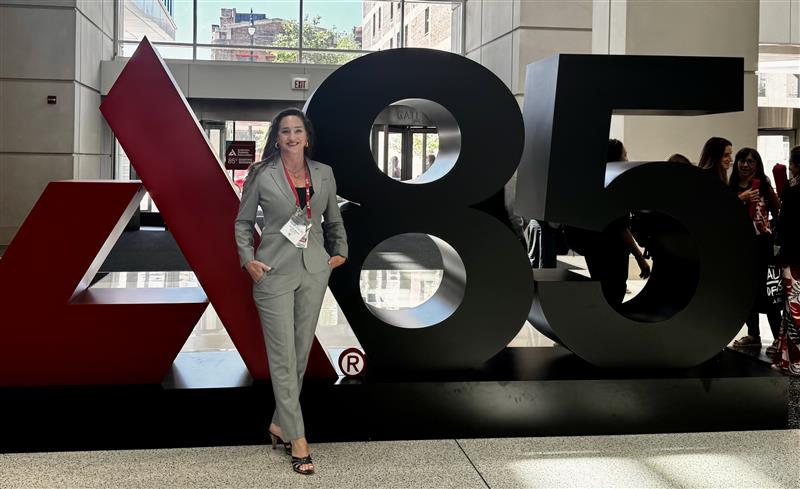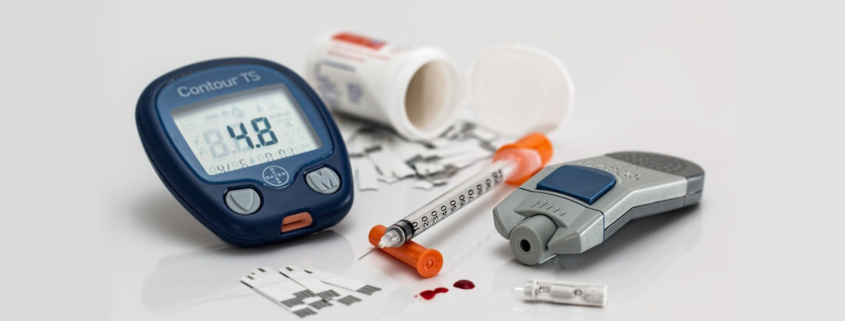Interviewed by Jewels Doskicz
Chicago, IL, hosted the 2025 American Diabetes Association (ADA) Scientific Sessions, bringing together a diverse community of experts dedicated to advancing diabetes care and research. The sessions sparked excitement and inspired hope, highlighting cutting-edge diabetes research, technology, and novel therapies.
“The energy level at ADA 2025 was unlike anything I’ve experienced in a while,” explained Jennifer Okemah, MS, RDN, CDCES, and owner of Salute Nutrition. “As soon as I stepped through the door, the vibe was really exciting, and I can’t define why — it just was.”

A renewed focus on insulin-producing cells — whether preserved or even regenerated — reignited her belief in a potential cure for type 1 diabetes (T1D). Join Okemah as she shares her insights as a CDCES on key scientific breakthroughs, game-changing technologies, and emerging therapies that made waves at ADA 2025.
Delay, Prevent, Cure
A great deal of research is underway, from the early detection of T1D autoantibodies to delaying the diagnosis of T1D and preserving beta cell functioning, explained Okemah.
First, there’s Tzield®, a 14-day infusion to potentially delay the onset of T1D (in those who qualify) and are in Stage 2 T1D. It’s been taking center stage lately, but its effects don’t last forever — on average, it delays T1D by about two years.
It makes sense that, secondary to Tzield, research is underway to treat those newly diagnosed with Stage 3 T1D with various strategies to preserve their beta cells, such as the JAKPOT, Frexalimab, T1D RELAY, and CLVer studies.
While delay and prevention research and treatments on the horizon are full of promise, Okemah raises an important question: “What about the T1D population with completely obliterated beta cells?” She emphasizes that this type of therapy represents the “true cure.”
The future looks promising here, with several companies, including Vertex, Sernova, Sana Biotechnology, and SymbioCellTech, working on curative therapies with insulin-producing cells.
Okemah explained that researchers are exploring different approaches, which is exciting, particularly with the work on beta cell preservation and replacement with short use of immunosuppressant drugs, or none at all.
“It’s not just a matter of ‘is there a cure?’ There is a cure. The real questions are: How efficient can we be? How quickly can we bring it to market and make it accessible for people with T1D?”
“I believe it’s possible, but how do we get there?”
Continuous glucose monitoring (CGM) and Continuous ketone monitoring (CKM) systems
“We have a lot of CGMs on the market today that interact with AID systems, along with implantable CGMs. I’m particularly excited about Abbott’s new continuous glucose-ketone monitoring system (CKM).”
As the name implies, the Abbott sensor will continuously monitor glucose and ketone levels, helping to avoid potentially life-threatening DKA. It’s expected to launch in 2026 and integrate with multiple devices, including Tandem, Medtronic, Sequel, and Beta Bionics.
“Glucotrack has a new implanted venous CBGM device (meaning it’s using blood, not interstitial fluid),” said Okemah, who explained it’s surgically inserted into a vein and can be kept in place for up to three years. It’s expected to hit the market sometime in 2028 with real-time, accurate, continuous blood glucose monitoring.
“We rely on CGMs a lot, but with every technological device, we have to understand its limitations and educate people on them,” she said. “Many things can interfere with CGM readings, including hydration. So this could be an exciting option.”
“Senseonics’ implantable Eversense 365 has a full year of wear, and the patch is getting a new look. It’s set to integrate with Sequel’s Twiist™ using Tidepool’s Loop algorithm, now available for those age six and older.”
Twiist can tell the difference between air bubbles and insulin using sound waves, explained Okemah, allowing for more accurate insulin delivery with occlusion detection.
Finally, Dexcom announced a new G7 15-day sensor (15.5 days including the 12-hour grace period) that has received FDA clearance and is expected to be available by the end of 2025.
It’s important to note that Dexcom has said not all sensors last this long. “I hold my breath here,” said Okemah. ”We know there are issues in general with sensors, adhesives, and their replacement for users. So, will they provide two sensors a month after acknowledging that not all sensors will last 15 days, or will they send three instead? Please tell me, ‘yes.’”
Non-insulin hormone therapies
A group of non-insulin hormones is gaining increased attention and is exciting to look at, said Okemah. “Amylin is co-produced by beta cells along with insulin, yet we only supplement with insulin. Symylin, which is set to be discontinued this year, can cause a lot of nausea — however, it does reduce the amount of insulin required.”
“GLP-1s are getting closer to FDA approval in people with T1D. While we don’t have approval yet, they’re being used widely in type 1 — but we want these medications covered by insurance.”
She explained that the use of GLP-1 receptor agonists in T1D is particularly fascinating because research shows that it significantly reduces the amount of insulin someone needs, especially in those with overweight or obesity.
If we get CKM (as mentioned above), could that open the door to FDA approval for SGLT inhibitors in the type 1 population? Okemah would like to know more, considering the cautious approach to their use in T1D due to the risk of DKA.
“So, if we have glucagon, GLP-1, amylin, and insulin, this could create an exciting concoction — a sort of hormonal cocktail that we could fine-tune,” she said. “But ideally, we shouldn’t need to worry about that because we’re working on a cure.”
Inhalable insulin
Okemah is also excited about MannKind’s Afrezza® INHALE-1 pediatric diabetes study, demonstrating its safety and efficacy in children.
“Honestly, you can’t talk about insulin without talking about Afrezza. It’s an option for most people, but certainly doesn’t get the attention it deserves, even though it’s fantastic for various situations.”
“I think Afrezza should be in every clinician’s toolbox. With its proven safety record, it opens Afrezza to broader use,” said Okemah. “It’s great for stubborn highs, and I love how fast it works.”
“I always tell people that insulin has to climb Mt. Everest before it starts to bring your glucose down. Afrezza taps into the top of that mountain quicker and begins chipping away at it sooner.”
“I use that analogy because when I pull up data and see there’s been ‘correction, correction, correction.’ I know this individual has been struggling while doing what’s been recommended, but it takes time to see the result. Then, it becomes a situation of low logic, and I see ‘override, override, override’ because they just want to feel better.”
Here’s the thing: “A little bump of Afrezza can go a long way.”
Nutrition + Tech
Dexcom was excited to announce its new G7 smart food and event logging capabilities. While this product option will evolve, it’s in its early stages and is only available in the Dexcom 2.9 version.
Side note: Okemah had to delete and reinstall her app to update because it wasn’t automatically updating. That said, once it is updated, you’ll see an option to take a picture of food.
“What’s unique about it is that it’s an AI interaction, and Dexcom will restructure it on the platform’s back end, which should bring exciting changes. Right now, it’s mainly used retrospectively to help understand what happened the last time you ate a certain meal, but you can’t catalog it in any way.” So, it has functional limitations.
She said that while it doesn’t count carbohydrates, SNAQ (another connected health app) already does.
Something exciting to note is that you don’t have to be “exact” with carb counting and AID systems. “Data presented at ADA is showing estimations can work well, and this is how I educate. You can always take more insulin later. It’s really about understanding the algorithm and how it varies, especially when you switch between systems.”
Along these lines, Beta Bionics’ iLet meal announcements are grouped by meal (breakfast, lunch, dinner) and then into “usual,” “more,” or “less” options. They also offer the unique feature of following someone else’s data, and they’re about to launch a patch pump called Mint (available sometime in 2027).” It’s partially rechargeable and partially disposable, which is great for a smaller environmental footprint. Plus, they’re still working on a dual hormone pump (insulin and glucagon), which is getting closer now that we have stable glucagon, said Okemah.
Finally, a T1D innovator, Naomi Garlick, was at ADA with Glow gummies. “They’re 4-gram, yummy gummies for correcting lows, but they’re vegan, dye-free, and made of dextrose. They don’t get chewy or melt, and they don’t stick to your teeth. I love the innovation of someone living with type 1, and that they’re made of dextrose.”
How will ADA 2025 learnings impact your professional practice?
“I think my discussion around A1C and GMI (Glucose Management Indicator) will be slightly different,” she said.
“A1C doesn’t tell the whole story, and while we’ve always known this, it was our only measurement tool. Now, many clinicians are questioning whether A1C is still necessary.”
Okemah explained that GMI has caused some confusion. “For example, with Dexcom, you can open your Clarity report, and your GMI will pop up. It may show 6.7 while your last A1C was 7.1.”
In short, GMI data is more heavily weighted over the past two weeks, so it more accurately represents what’s happening right now. There’s no doubt that A1C and GMI are slightly discordant, but research suggests AI can potentially reduce this discrepancy.
”GMI is a snapshot of what we’re working with, given that someone continues with their current patterns,” she said. “The reality is, when someone comes in with an elevated A1C, I’d want to see the latest data (GMI) to understand what’s been happening most recently.”
“That’s why I encourage people to let go of a previous A1C — it reflects what happened 90 to 120 days ago.”




Leave a Reply
Want to join the discussion?Feel free to contribute!